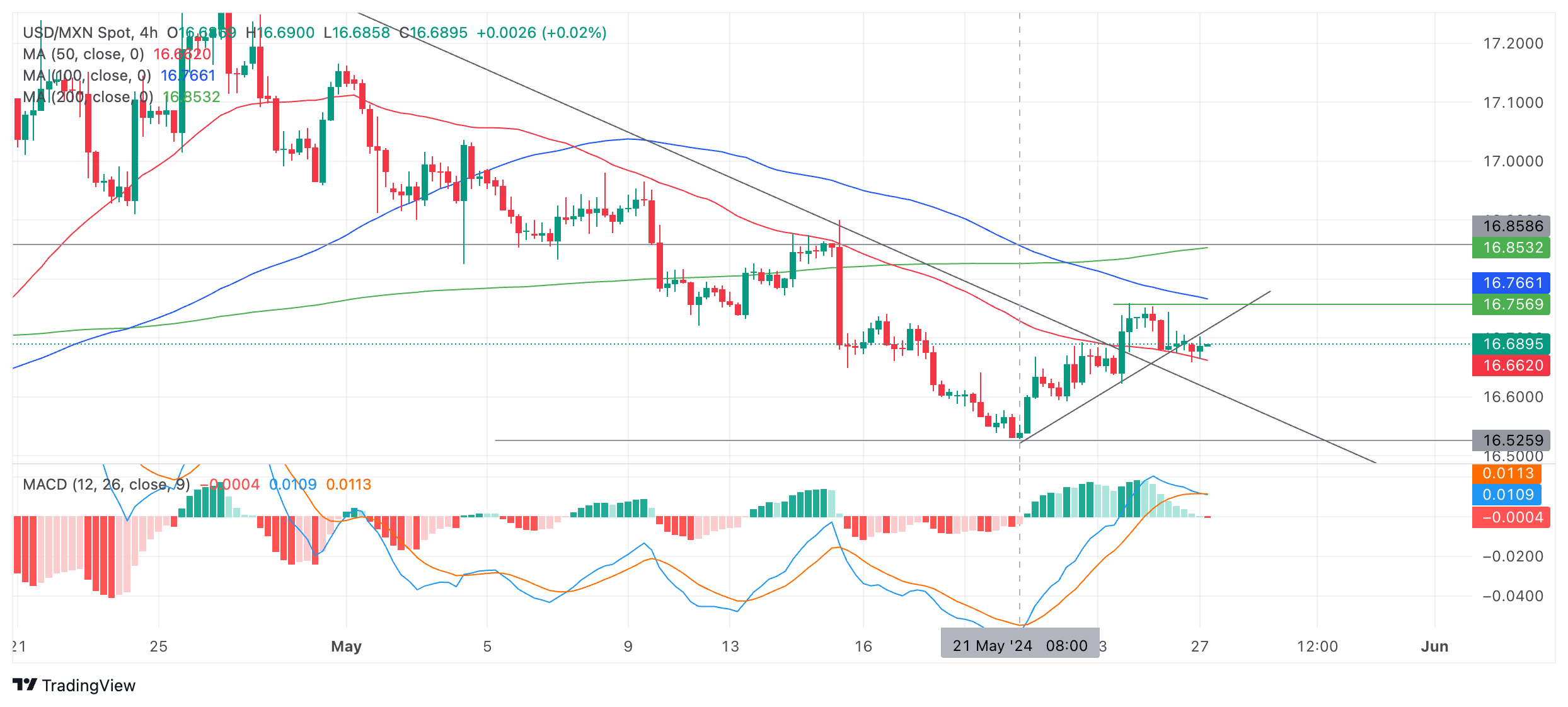- The Mexican Peso rises in its key pairs as investor risk appetite improves.
- China, Japan and South Korea reopen free-trade talks, tech stocks rally.
- Speculation of Banxico cutting interest rates in June is high, according to a leading poll.
The Mexican Peso (MXN) is rising in its key pairs due to strong investor risk appetite on Monday, which favors the Mexican Peso and commodity-linked currencies.
During the Asian session, stocks rose, with the Shanghai Composite clocking up gains of 1.14%; the Nikkei rising 0.61%, and Australia’s ASX200 up 0.83%. Optimism from the restarting of free-trade negotiations between China, Japan and South Korea – after they stalled in 2019 – and advances in technology stocks, were seen as factors supporting sentiment.
USD/MXN is exchanging hands at 16.68 at the time of writing, EUR/MXN is trading at 18.09 and GBP/MXN at 21.25.
Mexican Peso rises despite Citibanamex survey
The Mexican Peso recovers despite high expectations Banxico will lower interest rates this summer. A poll of economists held by Mexico’s second-largest bank, Citibanamex, showed that the majority of respondents estimated the Bank of Mexico (Banxico) will cut interest rates from 11.00% to 10.75% at its June 27 meeting. Lower interest rates are negative for a currency since they attract less foreign capital inflows.
The survey followed Banxico’s unanimous decision to keep interest rates unchanged at its May meeting.
Banxico’s May meeting Minutes showed policymakers championing a broad range of views, making it difficult to determine the future trajectory of Banxico’s policy rate. Stubborn services-sector inflation, however, appears to be a key factor holding Banxico back from planning further cuts.
The US Federal Reserve (Fed) is expected to further delay its first interest-rate cut after strong US economic data. The preliminary Purchasing Manager Index (PMI) data for May roundly beat expectations – especially in the services sector, which is also inflationary in the US. The odds of the Fed cutting in September are now at 49.4%, according to the CME FedWatch tool, which bases its calculations on interest-rate futures.
In Europe, meanwhile, European Central Bank (ECB) officials have all but committed to a June interest-rate cut although most policymakers appear to favor a data-dependent approach after that.
In the UK, the latest inflation data showed inflation cooling to 2.3%. However, this was not as low as expected. UK Retail Sales and data for April was weak although Consumer Confidence improved. Speculation remains high that the Bank of England (BoE) will cut interest rates in June as inflation declines closer to the BoE’s 2.0% target.
Technical Analysis: USD/MXN pulls back after tracking higher
USD/MXN – or the number of Pesos that can be bought with one US Dollar – has weakened a little since peaking on May 23, and has broken below the grey trendline of the recovery from the May 21 low. This has weakened the outlook somewhat, however, the new short-term uptrend remains intact and still favors longs over shorts.
USD/MXN 4-hour Chart

A break above the 16.76 (May 23 high) would probably confirm a continuation of the young uptrend to a possible target at the previous range lows around 16.85.
The Moving Average Convergence Divergence (MACD) indicator has crossed below its signal line, giving a sell signal and possibly indicating further weakness. A break below the swing low at 16.62 could indicate further weakness to the low of May 21 at 16.52.
Given the medium and long-term trends are bearish there also remains a risk of the pair continuing lower due to longer-term currents.
Mexican Peso FAQs
The Mexican Peso (MXN) is the most traded currency among its Latin American peers. Its value is broadly determined by the performance of the Mexican economy, the country’s central bank’s policy, the amount of foreign investment in the country and even the levels of remittances sent by Mexicans who live abroad, particularly in the United States. Geopolitical trends can also move MXN: for example, the process of nearshoring – or the decision by some firms to relocate manufacturing capacity and supply chains closer to their home countries – is also seen as a catalyst for the Mexican currency as the country is considered a key manufacturing hub in the American continent. Another catalyst for MXN is Oil prices as Mexico is a key exporter of the commodity.
The main objective of Mexico’s central bank, also known as Banxico, is to maintain inflation at low and stable levels (at or close to its target of 3%, the midpoint in a tolerance band of between 2% and 4%). To this end, the bank sets an appropriate level of interest rates. When inflation is too high, Banxico will attempt to tame it by raising interest rates, making it more expensive for households and businesses to borrow money, thus cooling demand and the overall economy. Higher interest rates are generally positive for the Mexican Peso (MXN) as they lead to higher yields, making the country a more attractive place for investors. On the contrary, lower interest rates tend to weaken MXN.
Macroeconomic data releases are key to assess the state of the economy and can have an impact on the Mexican Peso (MXN) valuation. A strong Mexican economy, based on high economic growth, low unemployment and high confidence is good for MXN. Not only does it attract more foreign investment but it may encourage the Bank of Mexico (Banxico) to increase interest rates, particularly if this strength comes together with elevated inflation. However, if economic data is weak, MXN is likely to depreciate.
As an emerging-market currency, the Mexican Peso (MXN) tends to strive during risk-on periods, or when investors perceive that broader market risks are low and thus are eager to engage with investments that carry a higher risk. Conversely, MXN tends to weaken at times of market turbulence or economic uncertainty as investors tend to sell higher-risk assets and flee to the more-stable safe havens.

























